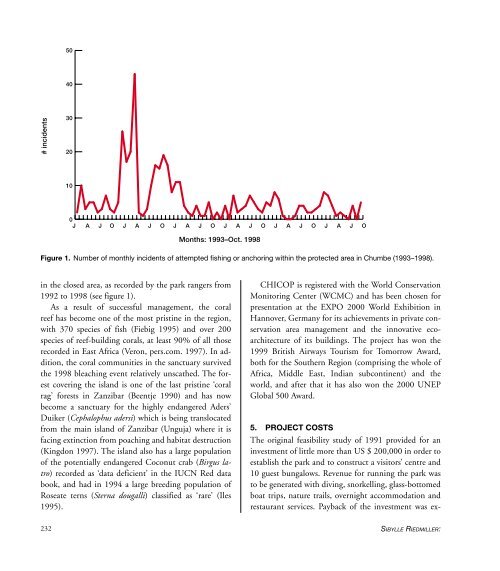You also want an ePaper? Increase the reach of your titles
YUMPU automatically turns print PDFs into web optimized ePapers that Google loves.
50<br />
40<br />
# incidents<br />
30<br />
20<br />
10<br />
0<br />
J A J O J A J O J A J O J A J O J A J O J A J O<br />
Months: 1993–Oct. 1998<br />
Figure 1. Number <strong>of</strong> monthly incidents <strong>of</strong> attempted fishing or anchoring within the protected area in Chumbe (1993–1998).<br />
in the closed area, as recorded by the park rangers from<br />
1992 to 1998 (see figure 1).<br />
As a result <strong>of</strong> successful management, the coral<br />
reef has become one <strong>of</strong> the most pristine in the region,<br />
with 370 species <strong>of</strong> fish (Fiebig 1995) and over 200<br />
species <strong>of</strong> reef-building corals, at least 90% <strong>of</strong> all those<br />
recorded in East Africa (Veron, pers.com. 1997). In addition,<br />
the coral communities in the sanctuary survived<br />
the 1998 bleaching event relatively unscathed. The forest<br />
covering the island is one <strong>of</strong> the last pristine ‘coral<br />
rag’ forests in Zanzibar (Beentje 1990) and has now<br />
become a sanctuary for the highly endangered Aders’<br />
Duiker (Cephalophus adersi) which is being translocated<br />
from the main island <strong>of</strong> Zanzibar (Unguja) where it is<br />
facing extinction from poaching and habitat destruction<br />
(Kingdon 1997). The island also has a large population<br />
<strong>of</strong> the potentially endangered Coconut crab (Birgus latro)<br />
recorded as ‘data deficient’ in the IUCN Red data<br />
book, and had in 1994 a large breeding population <strong>of</strong><br />
Roseate terns (Sterna dougalli) classified as ‘rare’ (Iles<br />
1995).<br />
CHICOP is registered with the World Conservation<br />
Monitoring Center (WCMC) and has been chosen for<br />
presentation at the EXPO 2000 World Exhibition in<br />
Hannover, Germany for its achievements in private conservation<br />
area management and the innovative ecoarchitecture<br />
<strong>of</strong> its buildings. The project has won the<br />
1999 British Airways Tourism for Tomorrow Award,<br />
both for the Southern Region (comprising the whole <strong>of</strong><br />
Africa, Middle East, Indian subcontinent) and the<br />
world, and after that it has also won the 2000 UNEP<br />
Global 500 Award.<br />
5. PROJECT COSTS<br />
The original feasibility study <strong>of</strong> 1991 provided for an<br />
investment <strong>of</strong> little more than US $ 200,000 in order to<br />
establish the park and to construct a visitors’ centre and<br />
10 guest bungalows. Revenue for running the park was<br />
to be generated with diving, snorkelling, glass-bottomed<br />
boat trips, nature trails, overnight accommodation and<br />
restaurant services. Payback <strong>of</strong> the investment was ex-<br />
232<br />
SIBYLLE RIEDMILLER:


















